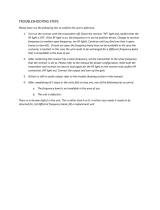
2
Important safety instructions
Important safety instructions
1. Read these safety instructions and the instruction manuals of the prod-
ucts.
2. Keep these safety instructions and the instruction manuals of the prod-
ucts. Always include these safety instructions and the instruction manuals
when passing the products on to third parties.
3. Heed all warnings.
4. Follow all instructions.
5. Do not use the products near water.
6. Only clean the products when they are not connected to the power supply
system. Use a dry cloth for cleaning.
7. Do not block any ventilation openings. Install the products in accordance
with the instructions given in the instruction manuals.
8. Do not operate near any heat sources such as radiators, stoves, or other
apparatus (including amplifiers) that produce heat.
9. Only operate the products from the types of power source specified in the
chapter “Specifications” on page 46 and indicated on the power supply
unit.
10. Only use the supplied power supply units.
11. Unplug the power supply units from the wall socket,
- to completely disconnect the products from the power supply system,
- during lightning storms or
- when not using the products for long periods of time.
12. Always ensure that the power supply units are
- in a safe operating condition and easily accessible,
- properly plugged into the wall socket,
- only operated within the permissible temperature range,
- not covered or exposed to direct sunlight for longer periods of time in
order to prevent heat accumulation.
13. Protect the power cords from being walked on or pinched, particularly at
the points where they exit from wall sockets, power supply units and prod-
ucts.
14. Only use attachments, accessories or spare parts specified by Sennheiser
15. Only use the products with the carts, stands, tripods, brackets, or tables
specified by Sennheiser, or sold with the products.
16. When a cart is used, use caution when moving the cart/product combina-
tion to avoid injury from tip-over.
17. When using the supplied device feet, do not place the products on delicate
surfaces. Delicate surfaces can become discolored or stained when they
come into contact with the plastic of the device feet.
18. Refer all servicing to qualified service personnel. Servicing is required
when the products have been damaged in any way, liquid has been spilled
or objects have fallen into the products, when the products has been
exposed to rain or moisture, do not operate normally, or have been
dropped.
19. WARNING: To reduce the risk of fire or electric shock, do not expose the
products to rain or moisture
20. Do not expose the products to dripping or splashing. Ensure that no
objects filled with liquids, such as vases, are placed on the products.





















